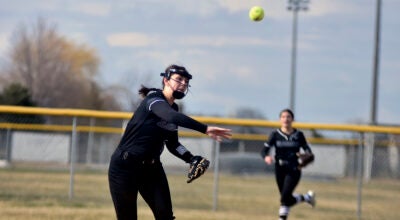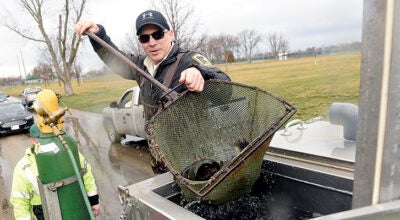‘The game is what the game is.’ Sano fastest to 1,000 strikeouts in MLB history
Published 5:07 pm Tuesday, September 21, 2021
|
Getting your Trinity Audio player ready...
|
By Phil Miller
Star Tribune
The pitch was traveling 99 miles per hour, letter-high but too close to take on an 0-2 count. Miguel Sano took a cut at Blue Jays closer Jordan Romano’s four-seam fastball Saturday night, but it was on him, then past him, before the barrel of his bat could come around.
Sano grimaced, then trudged straight ahead to the Twins dugout, a walk of frustration he has made many times before. In fact, one that he’s made more frequently, this early in his career, than anyone. The strikeout was Sano’s 1,000th and came in his 661st major league game, by far the fewest that any major leaguer had ever needed to reach four figures.
Which probably came as little surprise to Twins fans who have watched the slugger epitomize the storm surge of strikeouts that has gradually flooded baseball over the past two decades. More than one of every three times Sano has stood in the batter’s box over his career, 36.6% to be precise, he has trudged to the dugout without putting a ball in play.
“The game is what the game is — it’s difficult,” Sano said. “I know fans don’t like strikeouts. But when I go to the box, I’m trying to hit the ball hard. That’s my job. I can’t worry about anything else.”
That’s the crazy dynamic, one that both amazes and annoys the paying customers, of Sano’s career: He succeeds at crushing the ball at a rate that few others can. Well, of course, he does — nobody would get enough at-bats to strike out 1,000 times if he wasn’t doing something valuable at least part of the time. Two former MVPs are among the others in the top 10 quickest-to-1,000 list, after all.
“He’s been a very impactful, almost destructive force. He pulverizes the baseball. He’s gotten on base in his career at a pretty decent clip. He’s a guy that pitchers don’t want to face a lot of the time,” Twins manager Rocco Baldelli said. “Along with that does come some strikeouts, and that’s always going to be the case. In order for him to hit the ball over the fence, and the way his swing works, there’s going to be a little swing and miss, but we can live with that. I know I can.”
It’s more than a little swing and miss, of course. Sano has missed with 311 swings this season, among the top 20 in the major leagues. Though he has led the league in strikeouts only once, last season’s 90 whiffs in 53 games, he has racked up at least 115 every other season of his career, even in seasons when he has played fewer than half the games.
He’s already the Twins’ all-time leader in two-strikeout games (325), three-strikeout games (106) and four-strikeout games (18), and ranks third in franchise history in career strikeouts behind Harmon Killebrew (1,314) and Joe Mauer (1,034), each of whom played more than three times as many Twins games as Sano has. He owns five of the Twins’ 10 longest streak of games with a strikeout, including the record 23 in a row. And over the course of his career, when he is waiting on a two-strike pitch, he goes down on strikes 59.9% of the time.
Miguel Sano career statistics
“When I was younger, I worried about people booing because I strike out,” Sano said. “I try to get over it and learn from it. I don’t let it get in my mind.”
Sano has never struck out in fewer than this year’s 34.8% of his plate appearances, and has led the majors in that category four times in seven seasons including 2020, when he cratered at 43.9%. The major league average, highest it has ever been, is 24.2% this season.
“You never want to strike out, but it’s harder than ever now. Hitting is the hardest thing to do, and now you put 100 mph on it and it’s even harder,” commiserates Josh Donaldson, who by coincidence struck out for the 1,000th time on Sept. 7 in Cleveland, in his 1,177th game. “So many guys have nasty sliders and changeups and whatever, stuff that can deceive your eye.”
Yet like plenty of sluggers of the past, Sano also is a devastating hitter when he connects. His average exit velocity is 93.2 mph this year, seventh best in the majors. When he makes contact, 55.5% of time the batted ball is traveling 95 mph or more, which ranks sixth. He also owns three of the 10 longest home runs of the 2021 season, including a 495-foot monster that soared over center field and out of Boston’s Fenway Park.
Maddening? Sure. Fixable? Yes, say Sano and his coaches.
“This is a goal I told myself: Hit the ball more on the barrel and reduce strikeouts,” Sano said of what he hopes is a midseason breakthrough. “I start to use middle and right field more, and I don’t strike out as much. I try to hit it where it’s pitched, just hit it hard. And it’s better.”
His strikeout percentage, 36.4% in the season’s first half, has declined to 32.9% since the All-Star break, and there’s a reason, hitting coach Rudy Hernandez said. After a two-month hitting slump so egregious that Sano was temporarily benched, “he made a big adjustment. We all were working to try to get him to stay back on his back legs, so he can see the spin and the fastball better and have more time to get to the pitch,” Hernandez said. “He’s always had a hard time doing that. But finally, he started staying on his back legs more and he’s recognizing pitches better. He’s seeing them longer. He’s not trying to pull the ball. And you see the results.”
His strikeouts are down a bit, and his home runs are up. He has drawn more walks; his on-base percentage over the past two months ranks with Donaldson’s and Jorge Polanco’s; and his batting average is a respectable .253.
“To me, it looks like he’s not going up there with that all-or-nothing mentality. Earlier in the season, he took more swings that were that way,” Donaldson said. “Miggy’s a big strong guy, so barrel on the ball equals something loud. But you don’t have to hit it 500 feet. Down the line here, 330 will do it.”
And for proof that developing better plate discipline mid-career is possible, Donaldson said, look no further than him. In his first full season as a big-leaguer, “I didn’t draw my first walk until my 100th plate appearance,” he said. “People who say you can’t learn how to manage the strike zone and manage walks and strikeouts, they don’t know what they’re talking about.”





